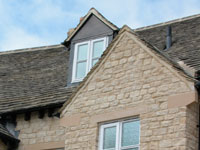Natural Look
Cardinal slates are often specified by architects looking for a close match to natural stone but at a big reduction in cost, even on Grade II buildings, in Conservation Areas or in Areas of Outstanding Natural Beauty (AONBs). Lists of examples for the following District Councils where Cardinals or other reproduction or reconstituted stone tiles have been given planning permission in these situations are available on request.
- West Oxfordshire District Council
- Wychavon District Council
- Cotswolds District Council
- Vale of White Horse District Council
- Stroud District Council
- Cherwell District Council
- Cheltenham Borough Council
Over 130 Different Moulds
When natural slate is quarried each slate is unique in shape and size. Most of our competitors have a range of between 10 and 30 different slates. We have over 130, with a wide variety of widths and lengths. This variety, however, means we can't provide a colour matching service.
Colours
Because we vary the amount of pigment in each batch of concrete and apply more to each mould by hand, each slate differs in colour giving an even more natural looking roof. You can expect the slates to lighten over a period of years as the surface colouring wears off but then become darker as they weather naturally. This variation also means that the range of colours as supplied will change slowly over time.
Speaking of lichens and moss, the many tiny pits in the surface of our tiles and the slow-release fertilizer we put in our colour encourage their growth (although we can't guarantee it!).
Cost
We brag about how good our slates are but because we've managed to keep our overheads low we're also able to brag about our prices. Cast-in nibs and nail holes help make Cardinals quick to install, too.
Strength
Because we cast our slates in enclosed moulds, they don't suffer the same quality control problems that sometimes affect other manufacturers. We test every day's production of concrete to check its strength, which is typically 60 to 70 N/mm2 after 14 days, the same as structural concrete.
|



